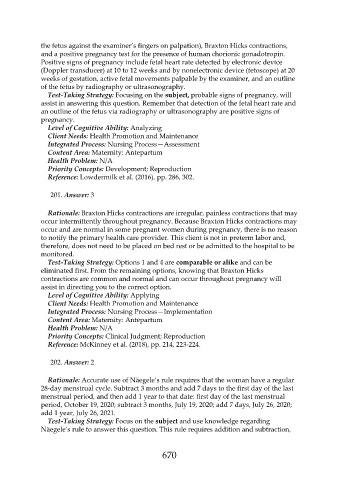Page 670 - Saunders Comprehensive Review For NCLEX-RN
P. 670
the fetus against the examiner’s fingers on palpation), Braxton Hicks contractions,
and a positive pregnancy test for the presence of human chorionic gonadotropin.
Positive signs of pregnancy include fetal heart rate detected by electronic device
(Doppler transducer) at 10 to 12 weeks and by nonelectronic device (fetoscope) at 20
weeks of gestation, active fetal movements palpable by the examiner, and an outline
of the fetus by radiography or ultrasonography.
Test-Taking Strategy: Focusing on the subject, probable signs of pregnancy, will
assist in answering this question. Remember that detection of the fetal heart rate and
an outline of the fetus via radiography or ultrasonography are positive signs of
pregnancy.
Level of Cognitive Ability: Analyzing
Client Needs: Health Promotion and Maintenance
Integrated Process: Nursing Process—Assessment
Content Area: Maternity: Antepartum
Health Problem: N/A
Priority Concepts: Development; Reproduction
Reference: Lowdermilk et al. (2016), pp. 286, 302.
201. Answer: 3
Rationale: Braxton Hicks contractions are irregular, painless contractions that may
occur intermittently throughout pregnancy. Because Braxton Hicks contractions may
occur and are normal in some pregnant women during pregnancy, there is no reason
to notify the primary health care provider. This client is not in preterm labor and,
therefore, does not need to be placed on bed rest or be admitted to the hospital to be
monitored.
Test-Taking Strategy: Options 1 and 4 are comparable or alike and can be
eliminated first. From the remaining options, knowing that Braxton Hicks
contractions are common and normal and can occur throughout pregnancy will
assist in directing you to the correct option.
Level of Cognitive Ability: Applying
Client Needs: Health Promotion and Maintenance
Integrated Process: Nursing Process—Implementation
Content Area: Maternity: Antepartum
Health Problem: N/A
Priority Concepts: Clinical Judgment; Reproduction
Reference: McKinney et al. (2018), pp. 214, 223-224.
202. Answer: 2
Rationale: Accurate use of Näegele’s rule requires that the woman have a regular
28-day menstrual cycle. Subtract 3 months and add 7 days to the first day of the last
menstrual period, and then add 1 year to that date: first day of the last menstrual
period, October 19, 2020; subtract 3 months, July 19, 2020; add 7 days, July 26, 2020;
add 1 year, July 26, 2021.
Test-Taking Strategy: Focus on the subject and use knowledge regarding
Näegele’s rule to answer this question. This rule requires addition and subtraction,
670

